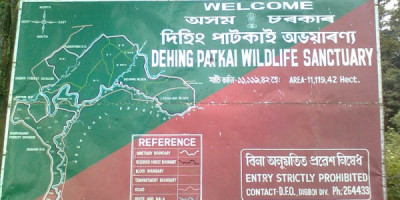In Depth
Why Visit Dehing Patkai National Park?
Dehing Patkai is not just a forest — it’s a living ecosystem that represents the true spirit of the Eastern Himalayas. It’s a paradise for nature lovers, wildlife enthusiasts, photographers, and researchers.
1. India’s Only Rainforest
Dehing Patkai is Assam’s only tropical rainforest, spread across nearly 231 sq km. The dense green canopy, flowing streams, and thick mist give it an Amazon-like feel, earning it the nickname “Amazon of the East.”
2. Rich Wildlife and Biodiversity
The park is home to over 300 species of birds, 40 species of mammals, 50 species of reptiles, and numerous butterflies and orchids.
Some notable animals found here include:
Clouded leopard, Hoolock gibbon (India’s only ape), Malayan giant squirrel, Asian elephants, Leopards, slow loris, and civets
3. Haven for Birdwatchers
Bird lovers can spot rare species such as scarlet minivets, hornbills, drongos, and woodpeckers. The early morning bird calls echo beautifully through the rainforest.
4. Perfect for Nature Photography and Eco-Tourism
The untouched forest, hanging roots, mossy trunks, and wild orchids make Dehing Patkai one of the most photogenic natural landscapes in Northeast India.
Eco-tourism is slowly growing here, offering visitors an authentic jungle experience without the crowds.
How to Reach Dehing Patkai National Park
Dehing Patkai is well-connected by air, rail, and road through Tinsukia and Dibrugarh.
By Air:
The nearest airport is Dibrugarh Airport (Mohanbari Airport), located about 80 km away. From there, taxis and local transport are available to reach the park.
By Train:
The nearest major railway station is Tinsukia Junction, approximately 60 km from the park. Regular trains connect Tinsukia with Guwahati, Dibrugarh, and other major Indian cities.
By Road:
Dehing Patkai can be easily accessed via National Highway 38. It’s a 2-hour drive from Dibrugarh and around 12 hours from Guwahati. Buses and private cabs are available from both towns.
Best Time to Visit Dehing Patkai National Park
The best time to visit Dehing Patkai is from November to April, when the weather is dry, cool, and pleasant.
Ideal Season (November–April):
Excellent for wildlife viewing and trekking.
Best visibility for photography and birdwatching.
Pleasant temperature ranging between 18°C to 28°C.
Avoid Monsoon (May–October):
Heavy rainfall can cause roadblocks and flooding.
Most areas become inaccessible due to dense vegetation and slippery terrain.
Nearby Attractions
If you’re planning a longer trip, you can also explore:
Digboi Oil Refinery (Asia’s oldest oil refinery)
Namphake Buddhist Monastery
Lekhapani and Stilwell Road (WWII historical sites)
Dibru-Saikhowa National Park
These attractions make Tinsukia a complete eco-cultural travel destination.
Travel Tips for Visitors
Hire a local guide for the best experience and safety.
Wear light cotton clothes, trekking shoes, and carry insect repellent.
Avoid littering and maintain silence during wildlife viewing.
Carry binoculars and a good camera for spotting birds and animals.
Stay at eco-friendly resorts or forest lodges near the park entrance.
Conclusion
Dehing Patkai National Park is one of Assam’s most beautiful and unexplored treasures — a rainforest that breathes life, color, and mystery. Whether you’re a nature lover, wildlife enthusiast, or traveler seeking peace, this park promises a once-in-a-lifetime experience.
Visit between November and April, explore the dense forests, listen to the calls of rare birds, and witness the untamed beauty of Assam’s “Amazon of the East.”
